AUDI S8 2011 Owners Manual
Manufacturer: AUDI, Model Year: 2011, Model line: S8, Model: AUDI S8 2011Pages: 302, PDF Size: 76.07 MB
Page 271 of 302
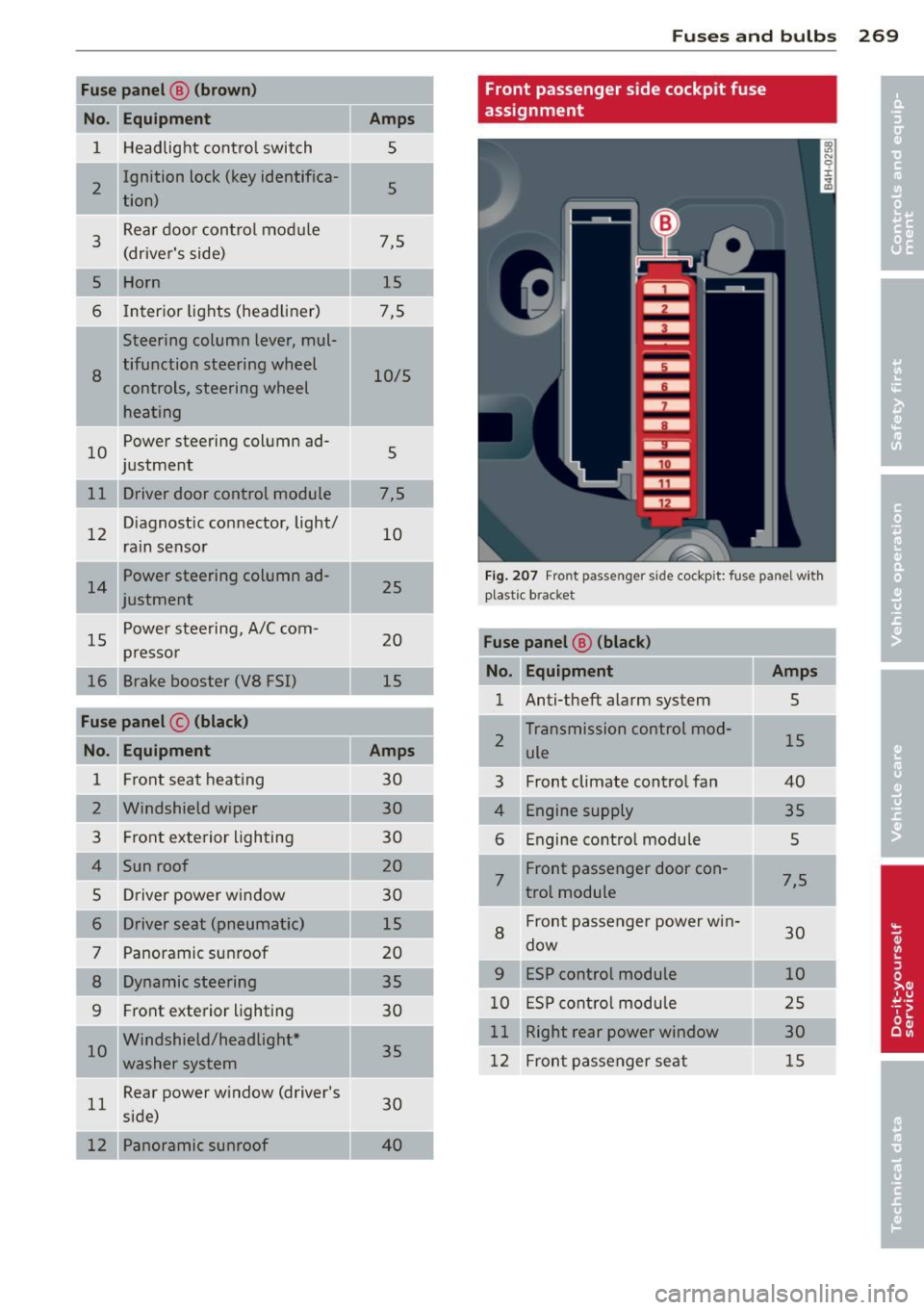
Fuse panel@ (brown)
No. Equ ipment
1 H eadlight contro l switch
I 2
Ignition lock (key identifica-
tion)
3
Rear door control mod ule
(driver's side)
5 Horn
6 Interior lights (head liner)
Steering column lever, mul-
8
tifunction steering wheel
controls, steering wheel
heating
10
Power steering column ad-
j ustment
11 Driver door control module
12
D iagnostic co nnector, light/
rain sensor
Power steering column ad-
justment
15
P ower stee ring, A/C com-
pr esso r
16 Brake booster (VS FSI)
Fuse panel © (black )
No. Equipment
1 F ront seat heating
2 Windshield wiper
3 Fr ont exterior lighting
4 Sun roof
5 Dr iver power window
6 Driver seat (pneumatic)
7 Panoramic sunroof
8 Dynamic steering
9 Fr
ont exterior lighting
I 10
Windshield/headlight *
washe r system
11
Rear power w indow (driver's
side)
12 Panoramic sunroof
Amp s
5
5
7,5 15
7,5
10/5
5
7,5 10
25
20
15
Amps
30 30
30
20
30
15
20 35
30
35
30
4 0
Fu se s and bulb s 269
Front passenger side cockpit fuse
assignment
Fi g. 2 07 Fro nt passe nger s id e co ckpit: f use pa nel w it h
plast ic brac ket
Fuse panel ® (black)
No . Equipment Amps
1 Anti-theft alarm system 5
2
Transmission control mod-
15 ule
3 Front climate control fan 40
4
Engine supply 35
6
Engine cont ro l module 5
7
Front passenger door con-7,5
t rot module
8
Fron t passe nger power w in-
30 dow
9 ESP control module 10
1 0
E S P cont ro l modu le 2 5
11
Right rear power window 30
12
Fron t passe nger seat 15
Page 272 of 302
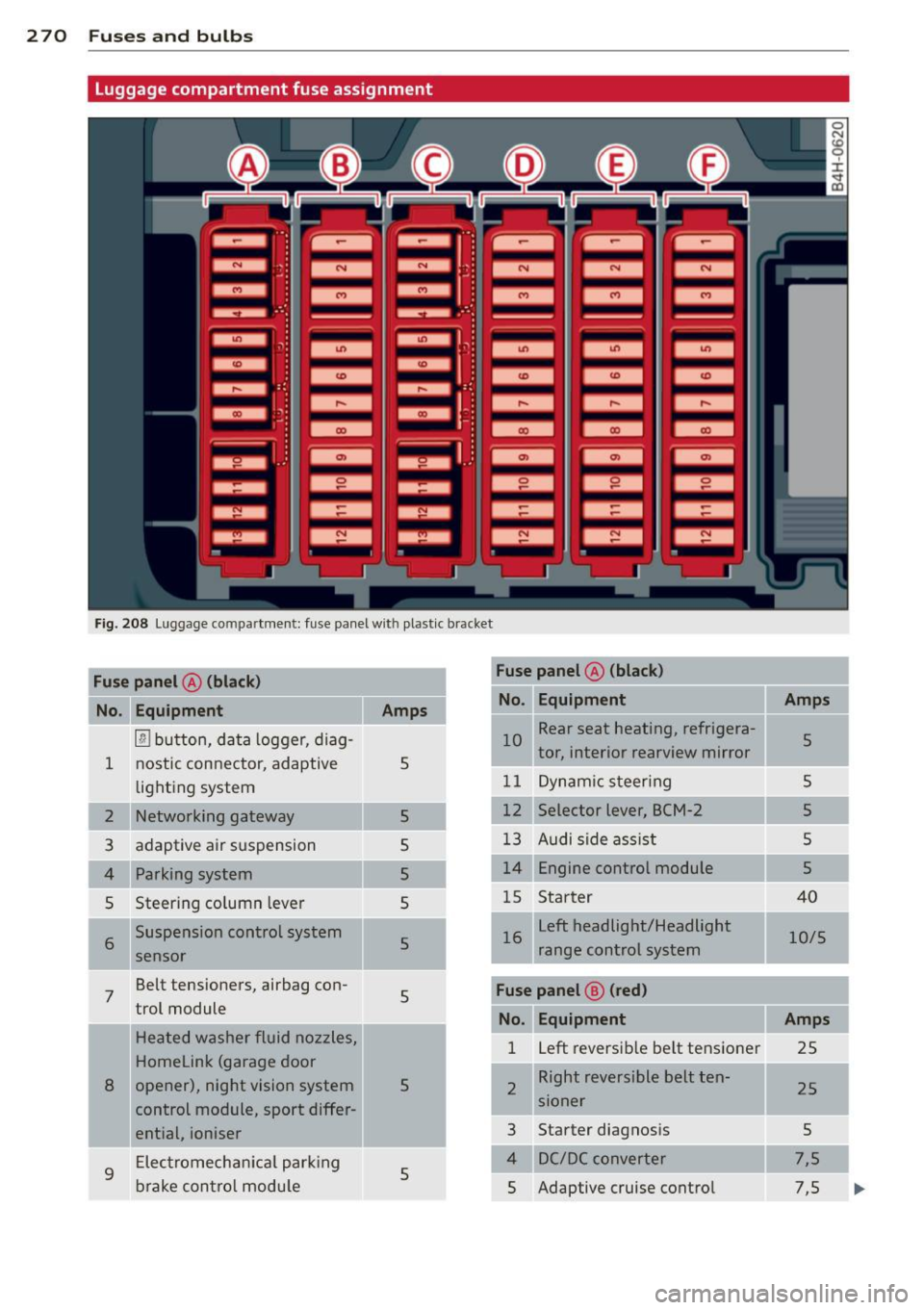
2 70 Fu ses and bulb s
Luggage compartment fuse assignment
Fig. 208 Luggage co mpar tment: fuse panel with plastic b racket
Fu se pan el A (black ) Fuse panel
@ (b lac k)
I
No.
Equ ipment Amps No
. Equipment
Amps .
l!l button, data logger, diag-
1 nostic con
nector, adaptive
5 10
Rear seat heating, refrigera-
5 j tor, interior rearview mirror
lighting system 11 Dynam
ic steer ing 5
2 Networking gateway
5 12
Selector lever, BCM-2
5
3 adaptive air suspension
5 13 Audi side ass
ist 5
4 Parking system 5 14 Engine control module
5
5 Steering column
lever
5 1
5 Starter 40
I 6 Suspension control system
5
sensor left headlight/Headlight
'
16
10/5
range control system
.
7 Belt tensioners, airbag con-
5
trol module Fuse pan el@ (red)
No. Equipment Amps
Heated washer fluid nozzles,
Homelink (garage door
8 opener), night vision system
5
control module, sport differ- 1
left reversib
le be lt tens ioner
25
2 II
R_ight reversible belt ten-
25
s1oner
ential, ioniser 3
Starter diagnos
is
5
9
Electromechan ica l park ing
5
brake con tro l module 4 DC/DC converter
7,5
5 Adaptive cruise control 7,5
Page 273 of 302

Fuse panel@ (red)
No. Equipment
= '
I 6 Right headlight (headlight
with adaptive light)
I
7 ESP control module
8
9 Adaptive cruise control
Transmission control mod-
10 ule
11 Climate control system sen
sors
Fuse panel @ (brown)
No
. II Equipment
Electromechan ical parking
1 brake
2 Suspension control system
sensor
Right rear door control mod-
3 ule
4 Smart-Modul Tank
5 Front climate control system
controls
6 Rear climate control system
controls
7 Networking gateway
8 Refrigerator
Interface for spec ial func-
9 tions
12 Selector lever
13 Ambient lighting
14 Rear exterior lighting
15 Fuel pump
16 Electromechanical parking
brake
Fuse panel @ (black)
Equipment
3 Rear sockets*
5 adaptive air suspension
6 115-V socket
7 Electromechanical parking
brake
II
Amps
10
s
5
10
5
5
Amps
5
5
7,5 5
15
10 5
15
5
10
10
20
25
30
Amps
20
15
25
30
=
Fuses and bulbs 271
Fuse panel @ (black)
No. Equipment
8 Rear seat heating
9 Rear exterior lighting
10 Rear
climate control system
blower
Rear sun shade, closing aid,
11 luggage compartment lock,
keyless
go/entry, fuel filler
door
12 luggage compartment lid
control module
Fuse panel E (red)
No. Equipment
1 Rear
seat adjustment but-
tons
3 Left rear seat
(pneumatics)
5 Trailer hitch control modu le*
6 Left rear seat
7 Right rear seat
8 Trailer hitch control module*
9 Trailer hitch control module*
10 Right rear seat (pneumatics)
Fuse panel ® (brown)
No. Equipment
1 Radio receiver/sound ampli-
fier
Sound amplifier, Bang&
2 Olufsen Advanced Sound
System
Rear Seat Enterta inment, ra-
3 dio receiver/sound amplifier
Automatic dimming interior
5 rearview mirror, rearview
camera (parking aid)
6 DVD changer
7 TV tuner
8 MMI unit/drives
9
Instrument cluster, analog
clock
10 MMI Display
Amps
25
20
20
20
30
Amps
s
7,5
20
30
30
20
15
7,5
30
30 10
5
5
5
7,5
5
5
•
•
....
Page 274 of 302
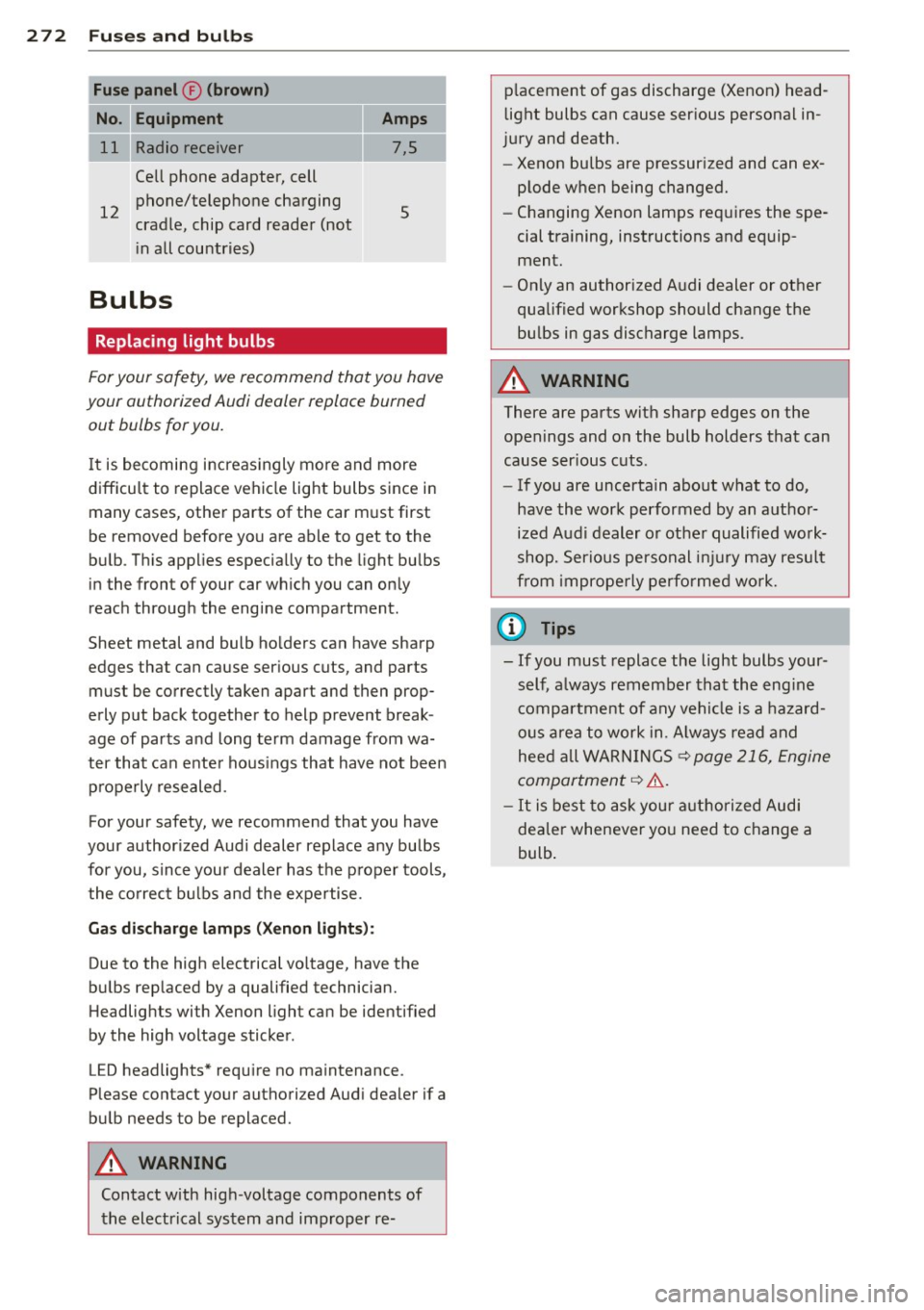
272 Fuses and bulbs
Fuse panel ® (brown)
No. Equipment
= 11 Radio receiver Cell phone adapter, cell
12 phone/telephone charging
cradle, chip card reader (not
i n all countries)
Bulbs
Replacing light bulbs Amps
= 7,5
5
For
your safety, we recommend that you have
your authorized Audi dealer replace burned
out bulbs for you.
It is becoming increasingly more and more
difficult to replace vehicle light bulbs since in
many cases, other parts of the car must first
be removed before you are able to get to the
bulb . This applies especially to the light bulbs
in the front of your car which you can only
reach through the engine compartment .
Sheet metal and bulb ho lders can have sharp
edges that can cause serious cuts, and parts must be correctly taken apart and then prop
erly put back together to help prevent break
age of parts and long term damage from wa
ter that can enter hous ings that have not been
properly resealed.
For your safety, we recommend that you have
your author ized Audi dealer replace any bulbs
for you, since your dealer has the proper tools,
the correct bulbs and the expertise.
Gas discharge lamps (Xenon lights):
Due to the high electrical vo ltage, have the
bulbs replaced by a qualified technician.
H eadlights with Xenon light can be identified
by the high voltage sticker.
LED headlights* require no maintenance .
Please contact your authori zed Audi dealer if a
bulb needs to be replaced.
A WARNING
Contact with high-voltage components of
the electrical system and improper re- placement
of gas discharge (Xenon) head
light bulbs can cause serious personal in
jury and death.
- Xenon bulbs are pressurized and can ex
plode when being changed.
- Changing Xenon lamps requires the spe
cial training, instructions and equip ment.
- Only an authorized A udi dealer or other
qualified workshop should change the bulbs in gas discharge lamps.
A WARNING
There are parts with sharp edges on the
openings and on the bulb holders that can
cause ser ious cuts.
- If you are uncertain about what to do,
have the work performed by an author
ized Audi dealer or other qualified work
shop. Serious personal injury may result
from imprope rly performed wo rk.
(D Tips
- If you must replace the light bulbs your
self, a lways remember that the eng ine
compartment of any vehicle is a hazard
ous area to work in. A lways read and
heed all WARNINGS¢
page 216, Engine
compartment¢ &..
-It is best to ask your authorized Audi
dealer whenever you need to change a
bulb.
Page 275 of 302
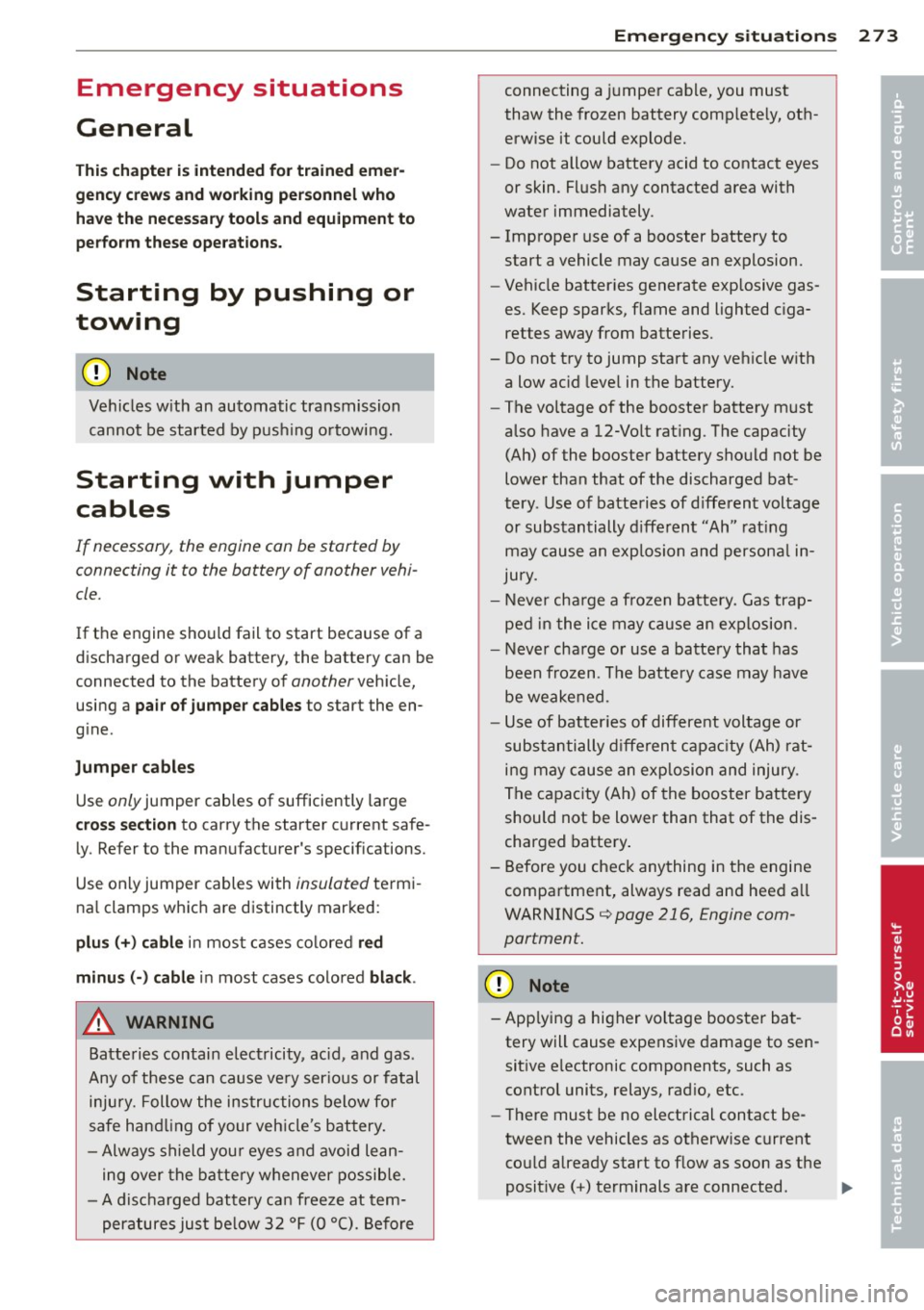
Emergency situations
General
This chapter i s intended for trained emer
gency crews and working personnel who have the necessary tools and equipment to
perform these operations.
Starting by pushing or
towing
CD Note
Ve hicles w ith an automatic tra nsmission
cannot be started by pus hing o rtowi ng.
Starting with jumper
cables
If necessary, the engine can be started by
connecting it to the battery of another vehi
cle.
If the engine shou ld fail to start because of a
discha rged o r wea k battery, the battery can be
connected to the battery o f
another vehicle,
using a
pair of jumper cables to start the en
g ine.
Jumper c ables
Use only jumper cables of sufficiently la rge
c ross section to carry the starter c urrent safe
l y . Refer to the man ufacturer's specifications.
Use only jumper cables with
insulated te rm i
na l clamps wh ic h are d istinctly mar ked:
plus(+) cable in mos t cases co lore d red
minus (-) cable
in most cases colored black .
A WARNING
Batterie s contain e lec tricity, ac id, an d gas.
Any of these can cause ve ry ser io us or fatal
inju ry. Follow the ins tructions below f or
safe han dling of your veh icle's b attery .
- Alway s sh ield you r eye s and avoid lean
i n g over the bat te ry w henever possib le.
- A dis ch arged battery c an free ze at tem
pera tures ju st below 3 2 °F ( 0 °C ). Befo re
Emergency situations 273
connecting a jumpe r cab le, you must
thaw the fr ozen battery c omp lete ly, ot h
erwise it could explode.
- Do not allow battery acid to contact eyes
or skin. Fl ush any contacted area with
wate r immediately .
- Improper use of a booster battery to start a vehicle may cause an explosion.
- Vehicle batter ies genera te exp losive gas
es. Keep spar ks, flame and lighted c iga
rettes away from batte ries.
- Do not try to jump start any ve hicle w ith
a low ac id leve l in the battery.
- The vo ltage of the booste r batte ry m ust
a lso have a 12-Vol t rating. T he capacity
(Ah) of the booster battery sho uld not be
lowe r tha n that of the discharged bat
tery . U se of batte rie s of d iffe ren t voltage
or substantially d iffe rent "Ah" rat ing
may c au se an exp losion and persona l in
Ju ry.
- N ever cha rge a fro zen battery. Gas tr ap
pe d in the i ce m ay cause a n ex plosion.
- Never cha rge or use a batte ry tha t h as
been fr ozen . T he battery case may have
be weakened.
- Us e of batter ies of differe nt voltage or
sub stant ia lly diffe ren t ca pa city (Ah) rat
i ng may c ause an exp losion an d injury .
Th e capac ity (Ah) of the booster bat tery
should not be lower than that of the dis
charged batte ry .
- Before you chec k any thing in the engine
compa rtment, always read and hee d all
WARNINGS
¢page 216, Engine com
partment.
CD Note
- App lying a higher voltage booster ba t
tery will cause expens ive damage to se n
sit ive e lectronic components, such as
cont rol units, relays, rad io , etc.
- There must be no electrical contact be
tween the vehicles as otherwise current
cou ld already start to f low as soon as the
posit ive(+) term inals a re connected. ..,. •
•
Page 276 of 302
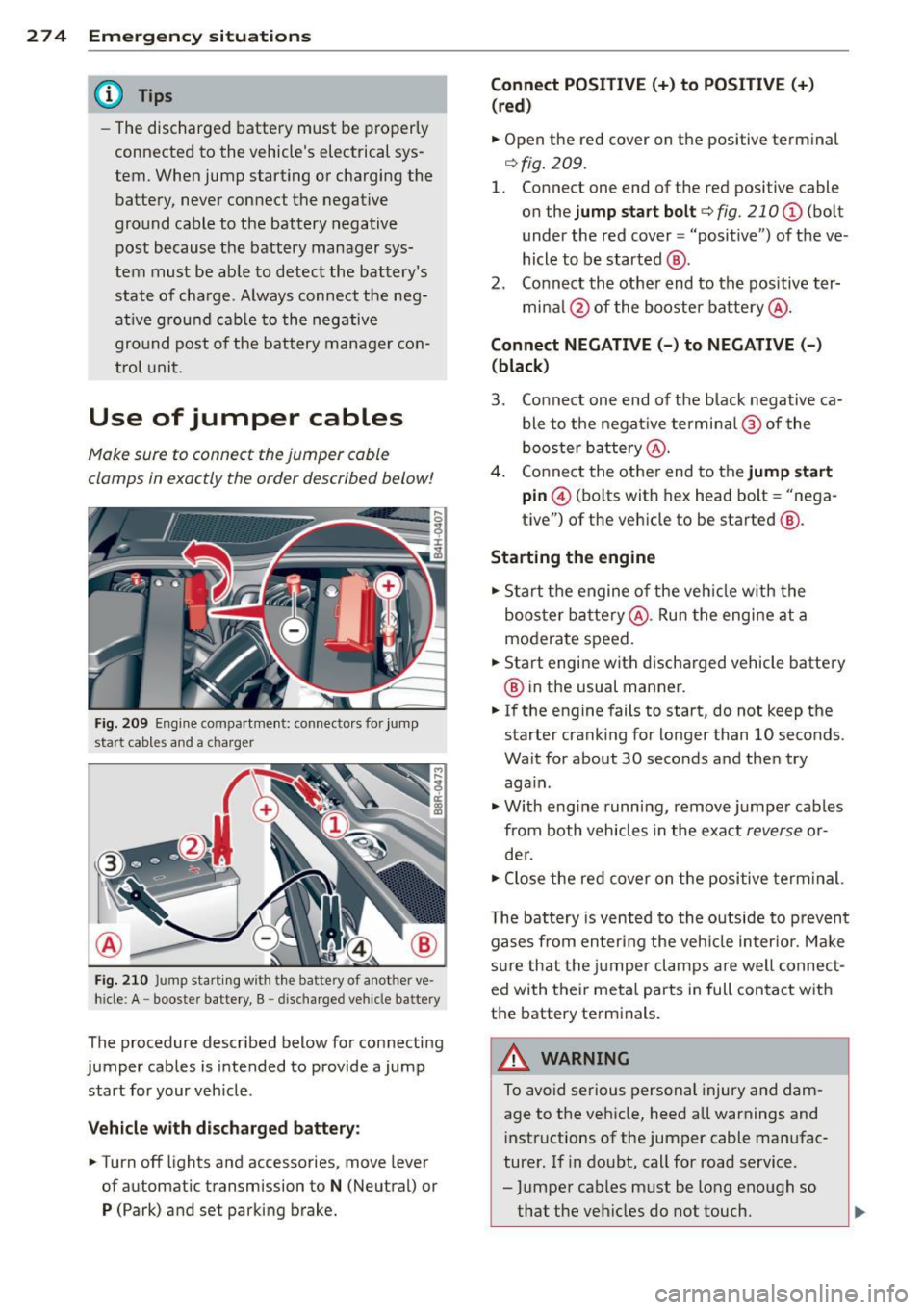
2 7 4 Emergency situations
@ Tips
-The discharged battery must be properly
connected to the vehicle's electrical sys
tem. When jump starting or charging the
battery, never connect the negative
ground cable to the battery negative
post because the battery manager sys
tem must be able to detect the battery 's
state of charge. Always connect the neg
ative g round cable to the negative
ground post of the battery manager con
trol unit .
Use of jumper cables
Make sure to connect the jumper coble
clomps in exactly the order described below!
Fig . 209 Engine compartme nt: connecto rs for jump
start cab les and a charger
Fig. 210 Jump starting w ith the battery of another ve
h icle: A - boos ter battery, B - discharged veh icle battery
The procedure described below for connecting
jumper cables is intended to provide a jump
start for your veh icle.
Vehicle with discharged battery :
.. Turn off lights and accessories, move lever
of automatic transmission to
N (Neutral) or
P (Park) and set parking brake.
Connect POSITIVE(+) to POSITIVE(+)
(red)
.. Open the red cover on the positive terminal
¢fig. 209 .
1. Connect one end of the red positive cable
on the
jump start bolt ¢ fig. 210@ (bolt
under the red cover = "positive") of the ve
hicle to be started @.
2 . Connect the other end to the positive ter-
mi nal @of the booster battery@.
Connect NEGATIVE (-) to NEGATIVE (-)
(black)
3. Connect one end of the black negative ca
ble to the negat ive terminal @ of the
booster battery @.
4. Connect the other end to the
jump start
pin © (bolts with hex head bolt= "nega
tive") of the vehicle to be started @.
Starting the engine
.. Start the engine of the veh icle w ith the
booster battery @. Ru n the engine at a
moderate speed .
.. Start engine with discharged vehicle battery
@ in the usual manner .
.. If the engine fails to start, do not keep the
starter crank ing for longer than 10 seconds.
Wait for about 30 seconds and then try aga in .
.,. With engine running, remove jumper cables
from both vehicles in the exact
reverse or
de r .
.. Close the red cover on the positive term inal.
T he battery is vented to the outside to prevent
gases from entering the vehicle inter ior. Make
s ur e that the jumper clamps are well connect
ed with their meta l parts in full contact with
the battery terminals.
_& WARNING
To avoid se rious personal injury and dam
age to the vehicle, heed all warnings and
in structions of the jumper cable manufac
turer. If in doubt, call for road service .
- Jumper cables must be long enough so
that the veh icles do not touch.
-
Page 277 of 302

-When connecting jumper cables, make
sure that they cannot get ca ught in any
moving parts in the eng ine compart
ment .
- Before you check anything in the engine
compartment, always read and heed all
WARNINGS ¢
page 216, Engine com
partment.
(D Note
Imprope r hook-up of jumper cables can r u
in the generator.
- Always connect POSITIVE( +) to POSI
TIVE(+), and NEGA TIVE( -) to NEGATIVE
( - ) ground post of the battery manager
control u nit.
- Check that all sc rew plugs on the battery
ce lls are screwed in firmly. If not, tighten
pl ugs p rio r to conn ecting clamp on nega
tive batt ery terminal.
- P lease note that the procedure for con
nect ing a jump er cable as describe d
above applies spec ifica lly to the case of
you r vehi cle be ing j ump s tarte d. When
you are giv ing a jump star t to an othe r ve
hicle, do
not connec t the negative( -) ca
b le to the negat ive (-) term inal on the
discharged battery@¢
fig. 210. In
stead, securely connect the negative(-)
cable to e ithe r a solid metal component
that is firmly bolted t o th e engine block
or to the engine block itself.
If the bat
te ry tha t is b eing cha rged does not vent
to the outside, es ca ping b attery gas
could ignite and ex plode!
Emergency towing
with commercial tow
truck
General hints
Your Audi requires special handling f or tow
ing .
The fo llow ing informa tion is to be us ed by
commercia l tow tr uck operators who know
h ow to ope rate thei r equipmen t sa fe ly.
Emergency s itu ations 2 7 5
- Ne ver tow your Audi. Towing will caus e
damage to the engine and tran smission.
- Never wrap the safety chain s or winch ca
ble s around the brake lines.
- To prevent unnece ssary damage , your Audi
must be transported with a flat bed truck.
- To load the vehicle on to the fl at bed , use
the towing loop found in the vehicle tools
and attach to the front o r rear anchora ge
¢page 275 and ¢page 276.
_& WARNING
A vehicle being towed is not safe for pas
sengers. Never allow anyo ne to ride in a
vehicle be ing towed, for any reason.
-
Front towing loop
Only install the front towing loop when it is
needed.
F ig. 21 1 Front bu mpe r: cove r
Fig. 212 Front bu mpe r: in stall ing t he tow ing loop
There are threads located behind the right
s ide of the front b umpe r where a towing loop
can be installed. The th reads are located be
hind a cover.
.. Remove the tow ing loop from the vehicle
t oo l kit .
Page 278 of 302
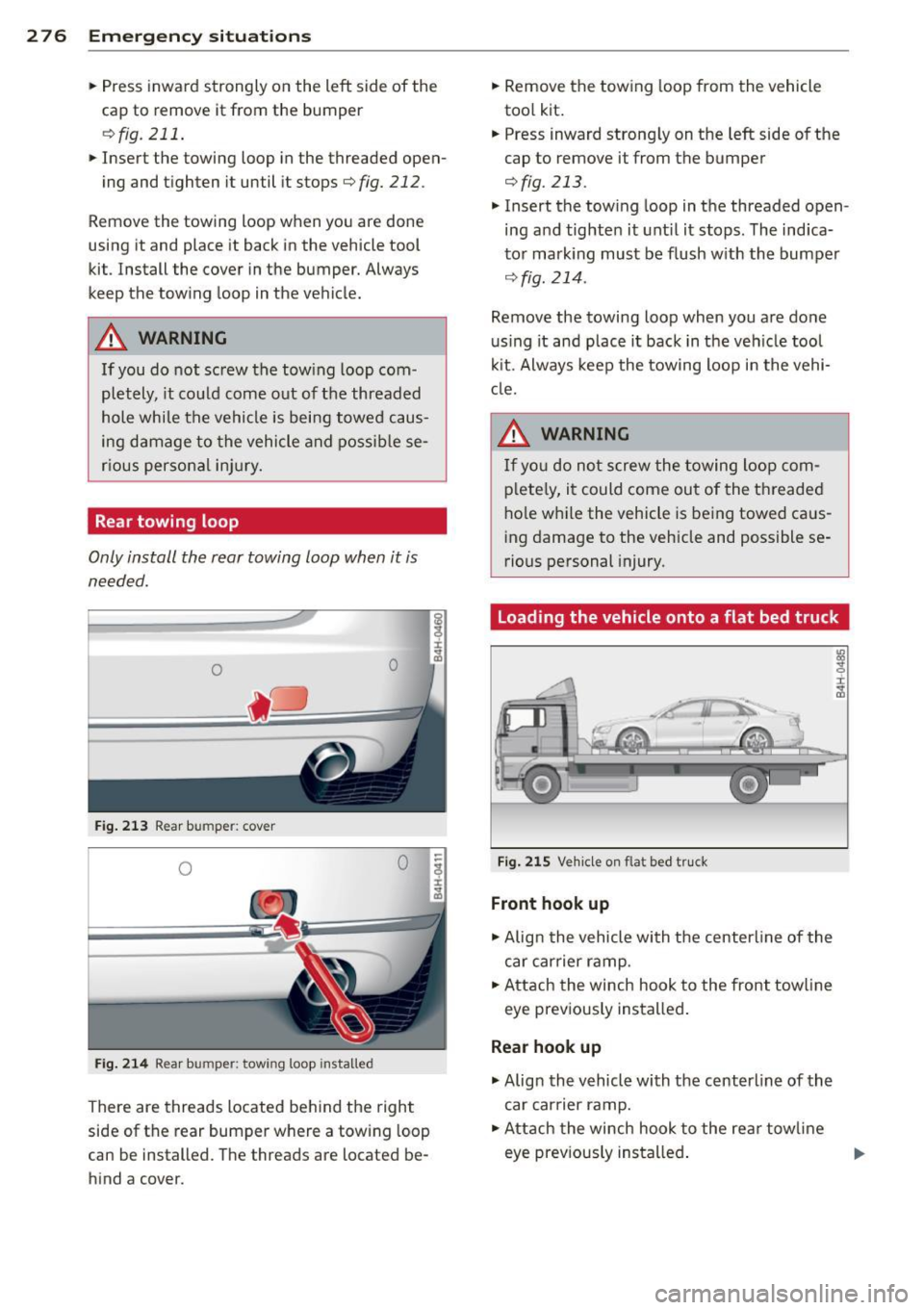
2 76 Em erg ency s it uat ions
• Press inward strongly on the left side of the
cap to remove it from the bumper
¢ fig. 211 .
• Insert the towing loop in the threaded open-
ing and tighten it until it stops¢
fig. 212.
Remove the towing loop when you are done
using it and place it back in the vehicle tool
kit. Install the cover in the bumper. Always
keep the towing loop in the vehicle.
A WARNING
If you do not screw the tow ing loop com
pletely, it could come out of t he threaded
hole while the vehicle is being towed caus
ing damage to the vehicle and possib le se
r ious personal injury.
Rear towing loop
Only install the rear towing loop when it is
needed.
0 0
Fig . 213 Rear bumper: cover
0
Fig. 21 4 Rear bu mper: towing loop installed
There are threads located behind the right
side of the rear bumper where a towing loop
can be installed. The threads are located be
hind a cover. •
Remove the towing loop from the vehicle
too l kit.
• Press inward strong ly on the left side of the
cap to remove it from the bumper
¢fig. 213.
• Insert the tow ing loop in the threaded open
ing and tighten it unt il it stops . The ind ica
tor mark ing must be f lush w ith the bumper
¢ fig. 214.
Remove the towing loop when you are done
using it and place it back in the veh icle too l
ki t. Always keep the towing loop in the vehi
cl e.
A WARNING
If yo u do not screw the towing loop com
p lete ly, it could come out of the threaded
ho le w hile the vehicle is being towed ca us
ing damage to the veh icle and possible se
rious personal injury.
Loading the vehicle onto a flat bed truck
F ig . 21S Ve hicle on flat bed truck
Front hook up
"" Align the vehicle with the centerl ine of the
car carrier ramp.
• Attach the winch hook to the front tow line
eye previous ly installed .
Rear hook up
"" Align the vehicle with the centerline of the
car earner ramp.
• Attach the winch hook to the rea r tow line
eye prev ious ly ins talled .
-
Page 279 of 302
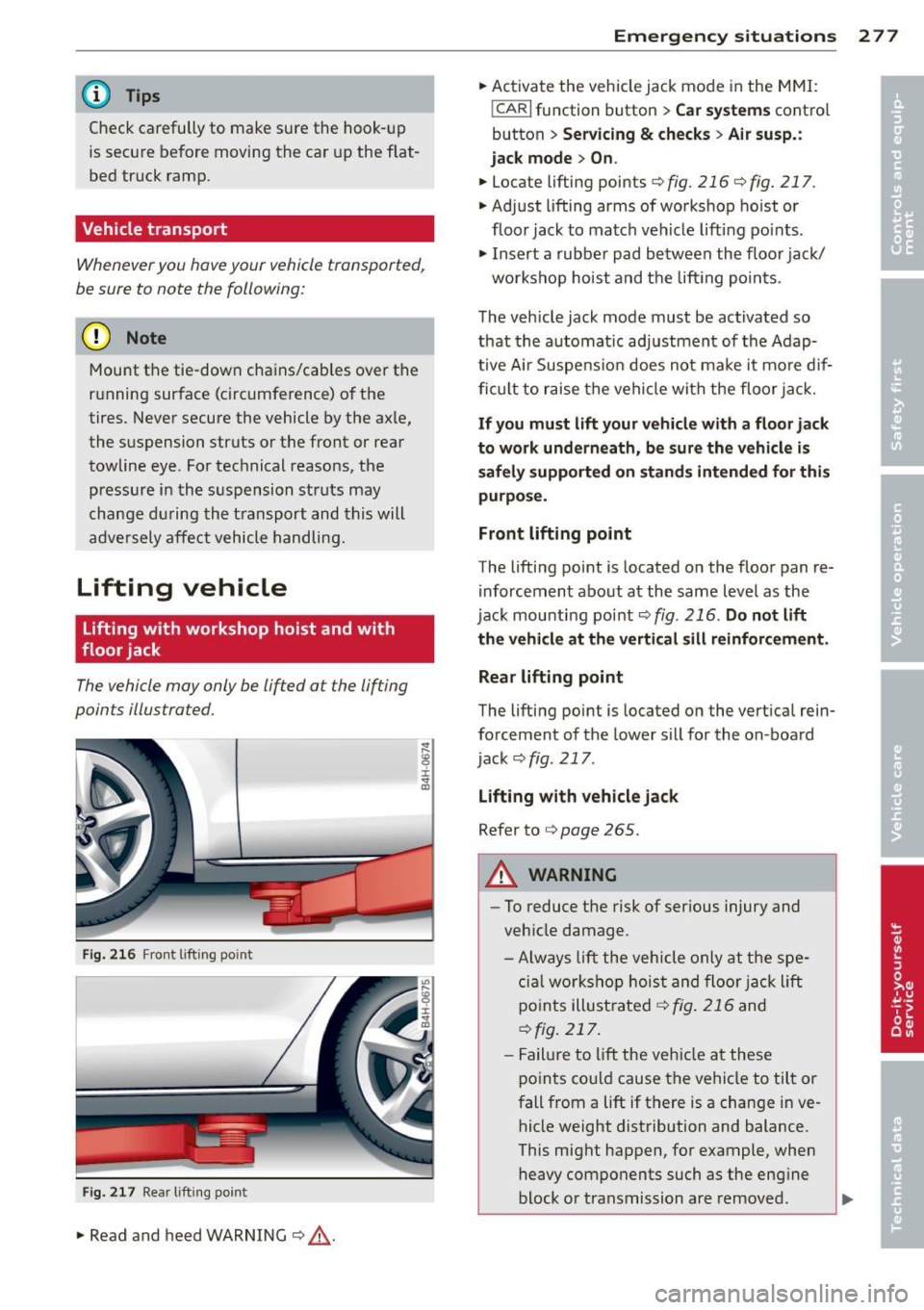
@ Tips
Check carefully to make sure the hook-up
is secure be fore moving the ca r up the flat
bed tr uck ramp .
Vehicle transport
Whenever you hove your vehicle transported,
be sure to note the following:
(D Note
Mount the tie-down chains/cab les over the
r u nning surface (ci rcumference) o f the
tires. Never secure the vehicle by the axle,
the suspensi on struts or the front or rear
towline eye . For tec hnical reaso ns, the
pressure i n the s uspension struts may
change du ring th e transport and this will
adve rsely affect vehicle handling.
Lifting vehicle
Lifting with workshop hoist and with
floor jack
The vehicle may only be li~ed at the lif ting
points illu stra ted.
Fi g. 2 16 Front l ift in g po int
Fi g. 217 Rea r lifti ng point
.. Read and heed WARNING r:::;, ,&. .
Emergency s itu ations 2 7 7
.. Ac tivate the vehicle jack mode in the M MI:
!CAR I fu nction button > Car systems contro l
button>
Servicing & checks > Air susp.:
jack mode > On .
.. Locate lifting points r:::;, fig . 216 r:::;, fig. 217 .
.. Adjust lifting arms of workshop ho ist o r
floor jack to matc h ve hicle lift ing po ints .
.. Insert a rubbe r pad b etween the floo r jac k/
works hop hoist and the li fting po in ts .
The vehicle jack mode must be activated so
that the a utomat ic adjustment of the Adap
tive Ai r Suspe nsio n does not make it mo re dif
fi cu lt to raise the vehicle wit h the floor j ack.
If you must l ift your vehicle with a floor jack
to work und erneath, be sure the vehicle is
safely supported on stand s intended for this
purpo se.
Front lifting point
The lifti ng point is located o n the floor pan re
inforcement a bout at the same level as the
jack mount ing point
r:::;, fig . 216. Do not lift
the vehicle at th e verti cal sill reinforcem ent .
Rear lifting point
The lifti ng point is located o n the vert ica l rein
forcement of the lower sill for the on -board
jack
r:::;, fig . 217 .
Lifting with vehicle jack
Refer tor:::;, page 265 .
A WARNING ~
-To reduce the risk of ser ious injury and
ve hicle damage.
- Alway s lift the vehicle only at th e spe
cial worksho p hois t and floor jack lift
po ints illust rate d
r:::;, fig. 216 and
¢ fig. 217 .
- Fail u re t o lift the ve hicle at these
po ints co uld cause t he vehicle to til t or
fall from a lift if there is a change in ve
hicle weight distribution and balance.
This mig ht happen, fo r example, when
heavy components such as the eng ine
block o r transmissi on are removed .
-
Page 280 of 302

2 78 Emergency situations
-When removing heavy components like
these, ancho r vehicle to ho ist o r add cor
responding weig hts to ma inta in the cen
ter of g ravity. Othe rwise, the vehicle
m ight tilt o r slip off t he hoist, causi ng
serious p erson al inju ry .
@ Note
- Be awa re of the following points befo re
li fting the vehicle:
- The vehicle should never be lifted or
jacked up from underneath the engine
oil pan, the transmission housing , the
front or rear axle or the body side membe rs. This could lead to serious
damage.
- To avoid damage to the underbody or
chassis frame, a rubber pad must be
inserted between the floor jack and
the lift points.
- Before driving over a workshop hoist,
check that the vehicle we ight does not
exceed the permissible lifting capacity
of the hoist .
-Before driving over a workshop hoist,
ensure that there is sufficient clear
ance between the hoist and low parts
of the vehicle.